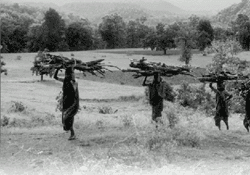Biodiversity blues
 There is concern that genes, species, and ecosystems are being lost due to deforestation. Climate change will aggravate this attrition problem by disrupting delicate relationships within ecosystems. Loss of biodiversity seems to be implicit in most global warming scenarios. Many species considered at risk now will become extinct.
There is concern that genes, species, and ecosystems are being lost due to deforestation. Climate change will aggravate this attrition problem by disrupting delicate relationships within ecosystems. Loss of biodiversity seems to be implicit in most global warming scenarios. Many species considered at risk now will become extinct.
l According to ipcc , the range and abundance of plants and animals could change dramatically under changing climatic conditions, and some species are likely to be unable to adapt or migrate to new locations. Most plants and animals can tolerate only a narrow range of ambient temperature. If the temperature varies significantly from this range, normal physiological functioning breaks down.
l Even more evolved forms of plants and animals that seem to be able to exist in wider climatic ranges need long periods of time to adapt to variations. If change is rapid, they will not be able to adapt, and will die out.
l Slow-moving species could lose out to weeds and pests that can move or adapt quickly. Plant and animal pests will be affected in the same way as human disease vectors.
l Rural and tribal communities all over India are dependent on biological resources for food, fuel, shelter and medicine. If there are shifts or movements in ecosystem affecting the biodiversity of a region, the people living in those areas will be deeply affected.
l Forests will migrate to higher altitudes and transform from drier to more moist types.
l Mountain ecosystems are projected to shift to higher elevations, although the rate of vegetation change is expected to be slow and the success with which they colonise new habitats will be constrained by local geographical features. For species that are already at their maximum altitude, this is not an option and extinction seems a distinct possibility.
l Biodiversity hotspots like the Western Ghats are an important resource base because of their high degree of endemism, biodiversity and productivity. Global warming could put their stability at risk since they cannot move to higher altitudes .
l Ecosystems that cannot move northwards at a rate dictated by global warming will be most at risk. These include glacial ecosystems, coral reefs and atolls, forests, Himalayan systems.
l Unlike many terrestrial ecosystems, coral reef ecosystems appear to be directly threatened by globally increasing atmospheric carbon dioxide . The calcification rates of corals, coralline algae, and coral-algal communities depend on calcium carbonate available in surrounding seawater, and is expected to be reduced by rising atmospheric carbon dioxide. This represents a serious climate-related threat to the functioning of reef ecosystems that will add to the already existing anthropogenic local stresses in places like the Andaman and Nicobar islands.
l Though coral reefs in these areas will most likely be able to keep up with the rise in sea level, they probably will not survive a rise in sea temperature.
l Global warming is already contributing to the decline of mangrove forests . Mangroves protect the shoreline, provide wood and fuel. They are also breeding sites for birds, and act as nurseries for fish. At places where urban development and industries are destroying mangroves, the problems caused by sea level rise and thermal stress will be particularly acute there.
l Salt-water intrusion from sea level rise will damage fresh water ecosystems . Loss of coastal wetlands will result in resident and migrating species having to shift their habitats.
Related Content
- Achieving global biodiversity framework targets in G20 countries by 2030
- Into the blue: securing a sustainable future for kelp forests
- Greening the blue report 2022
- Unlocking nature-smart development: an approach paper on biodiversity and ecosystem services
- Greening the Blue report 2020
- Building the climate change resilience of Mongolia’s blue pearl: the case study of Khuvsgul Lake National Park
